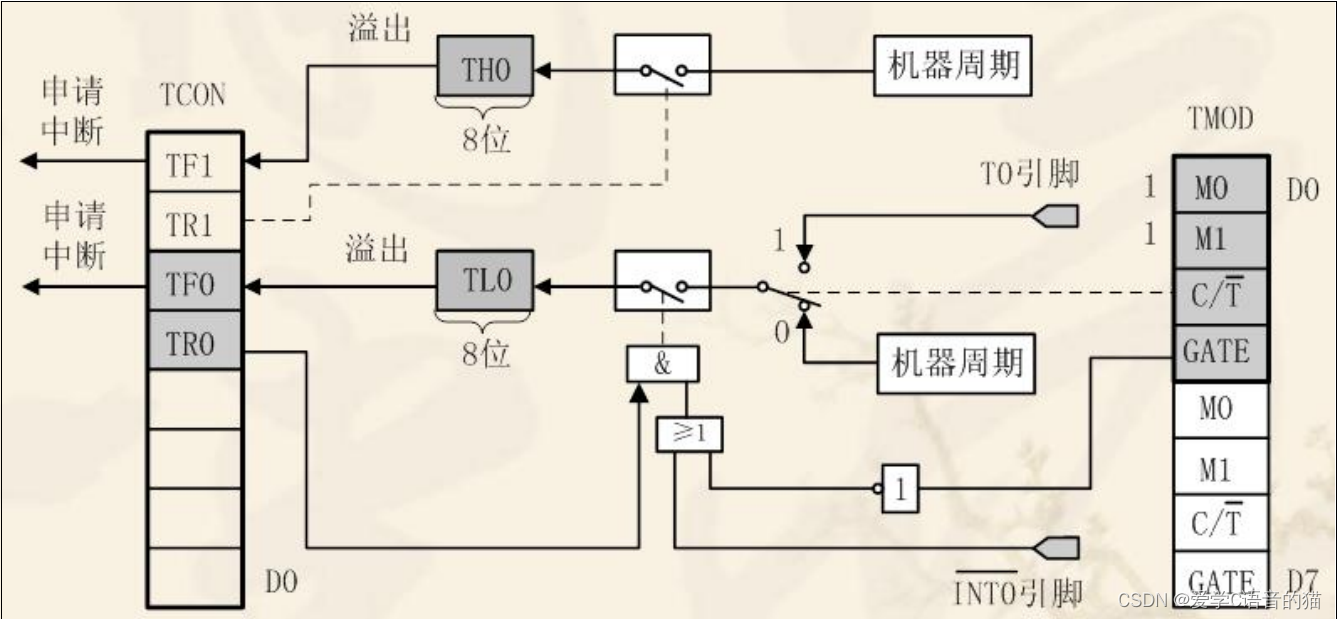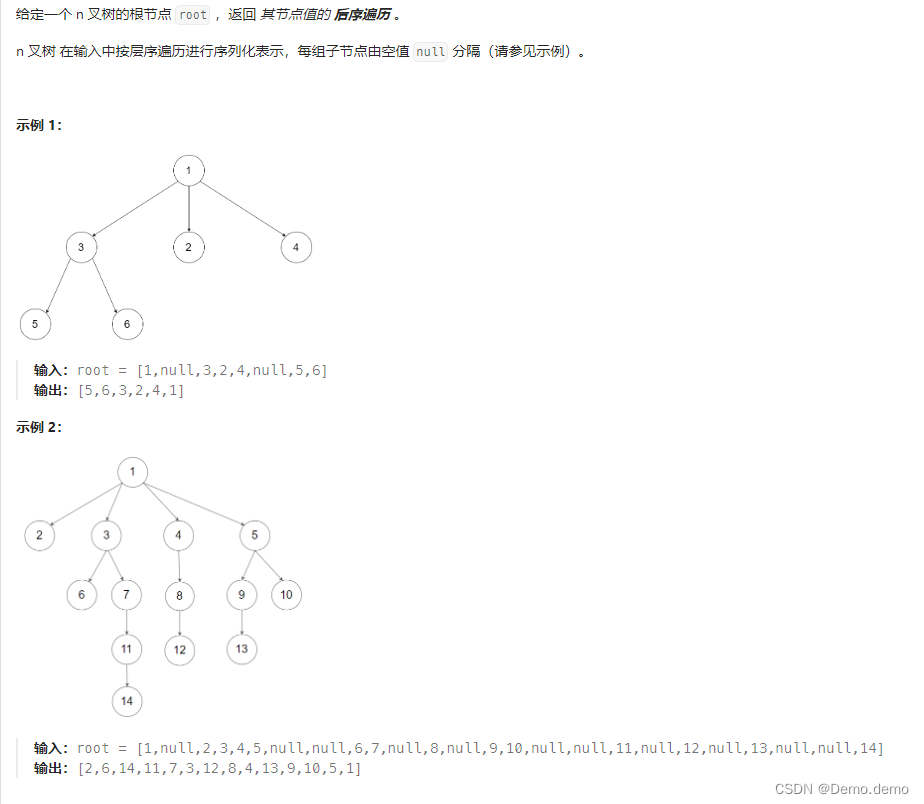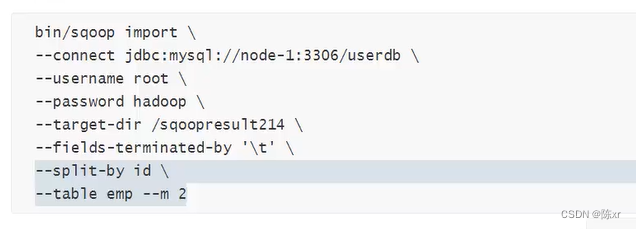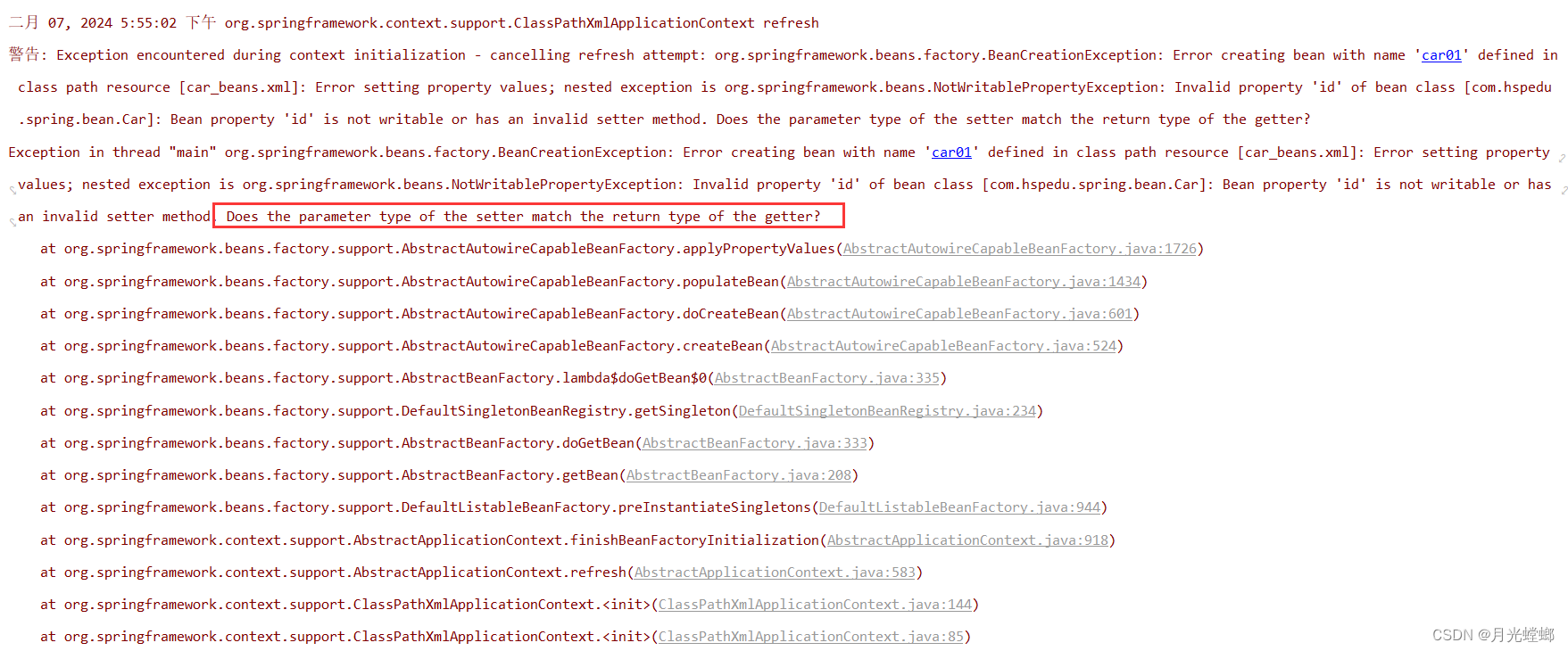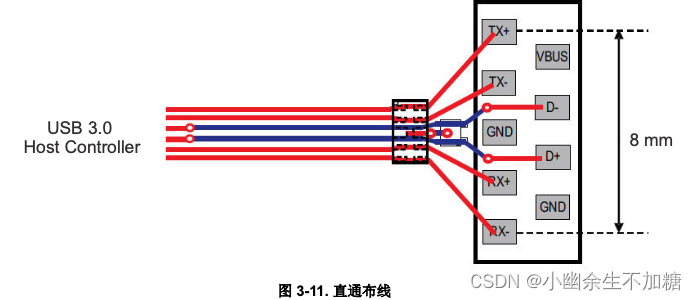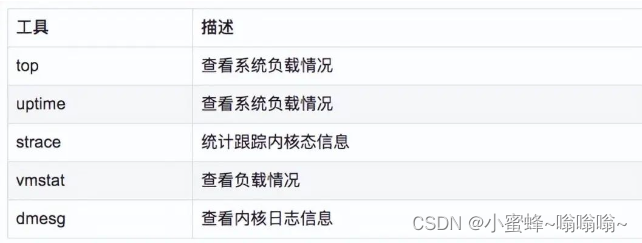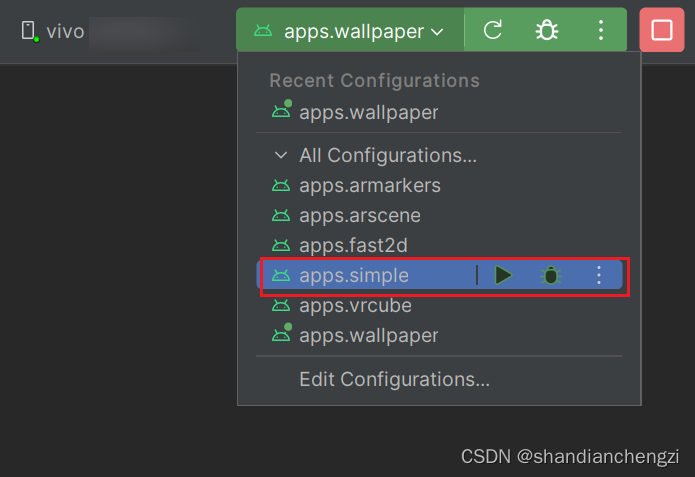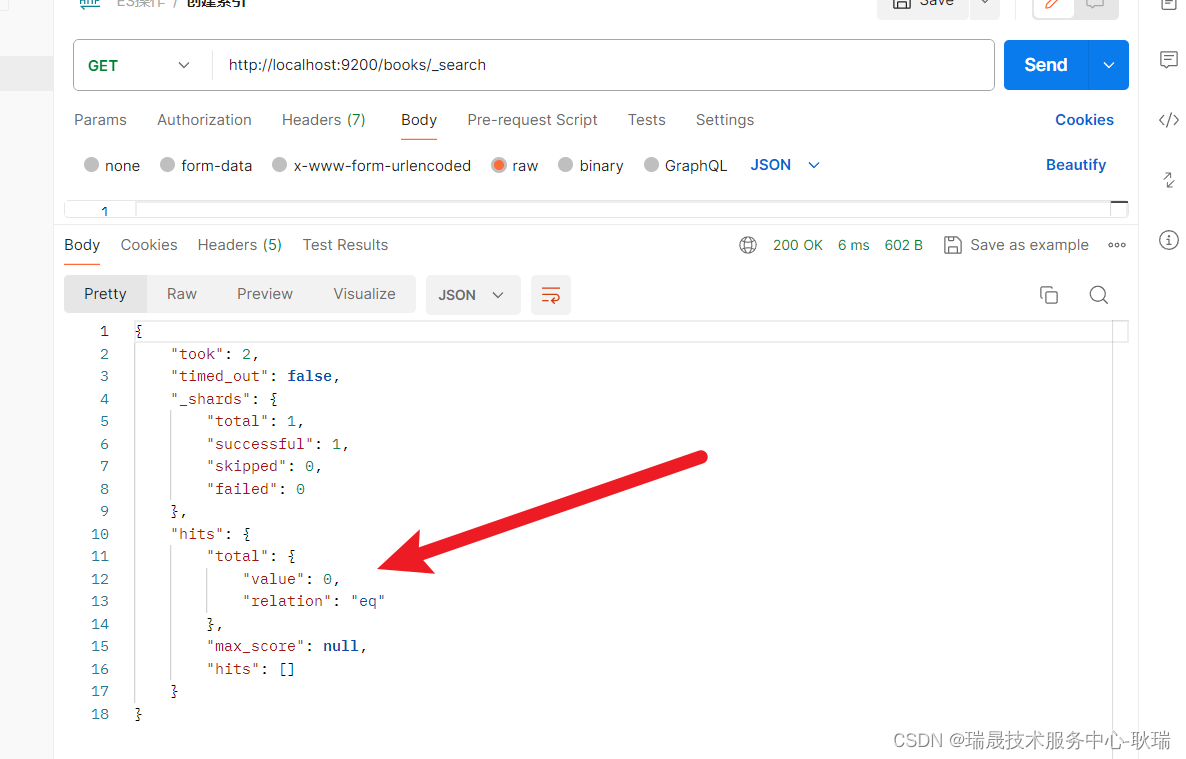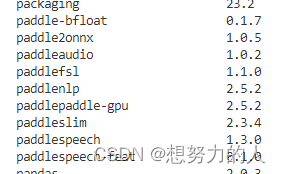JS渗透之咪咕登录
- 每篇前言:
- 咪咕登录
- 参数对比
- captcha参数
- enpassword参数
- 搜索enpassword参数
- 搜索J_RsaPsd参数
- setPublic函数
- encrypt加密函数
- 运行时可能会遇到的问题
- 此部分改写的最终形态JS代码:
- 运行结果
- python编写脚本运行此JS代码:
- 运行结果:
- loginID 参数
- 步骤同上面的enpassword,一步步搜索会发现找到了图中的J_RsaAccout,这个就是loginID参数的加密:(我们继续一步步分析,会发现此参数的加密方式和刚刚的enpassword的加密方式一模一样,那处理方法不就简单了!)
- 运行结果
- FingerPrint和FingerPrintDetail参数
- 找到指纹加密的主函数(会发现就在刚刚的函数下面)
- 分析函数功能
- 修改FingerPrint的JS函数
- 运行结果
- 编写爬虫脚本:
- (1)首先,编写脚本构造出post表单!
- (2)然后,编写脚本发送请求并通过获取响应判断是否登录成功!
- 第一步:直接向其发送请求,观察响应,是否为登录成功的界面!
- 第二步:所以下面我们要做的就是,通过分析浏览器登录,找到一系列的重定向的URL,并找到最终返回登录成功界面的URL:
- 第三步:构造登录成功之后的重定向URL,并通过依此请求模拟网站登录时候的一次次重定向跳转,最终达到获取咪咕登录成功的界面!
- (3)观察可知登录成功!
- 项目源码链接:
每篇前言:
🏆🏆作者介绍:【孤寒者】—CSDN全栈领域优质创作者、HDZ核心组成员、华为云享专家Python全栈领域博主、CSDN原力计划作者
- 🔥🔥本文已收录于爬虫进阶+实战系列教程专栏:《爬虫进阶+实战系列教程》
- 🔥🔥热门专栏推荐:《Python全栈系列教程》、《爬虫从入门到精通系列教程》、《爬虫进阶+实战系列教程》、《Scrapy框架从入门到实战》、《Flask框架从入门到实战》、《Django框架从入门到实战》、《Tornado框架从入门到实战》、《前端系列教程》。
- 📝📝本专栏面向广大程序猿,为的是大家都做到Python全栈技术从入门到精通,穿插有很多实战优化点。
- 🎉🎉订阅专栏后可私聊进一千多人Python全栈交流群(手把手教学,问题解答); 进群可领取Python全栈教程视频 + 多得数不过来的计算机书籍:基础、Web、爬虫、数据分析、可视化、机器学习、深度学习、人工智能、算法、面试题等。
- 🚀🚀加入我一起学习进步,一个人可以走的很快,一群人才能走的更远!
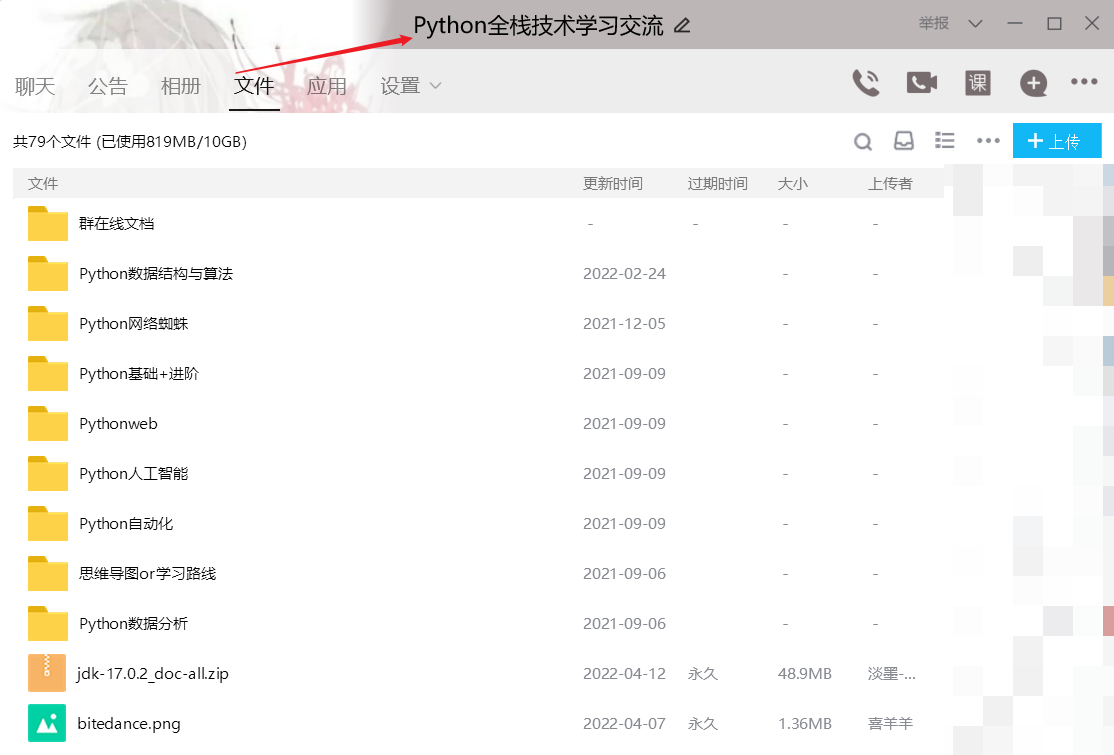
咪咕登录
之前的请求中找数据:
-
上级页面搜索: 静态页面搜索参数内容
-
本级页面:Network里搜索内容
复杂登录特点:
- 参数多
- 加密参数来源复杂
- 多次请求
简单拓展:
- Ajax请求的底层是基于XMLHttpRequests对象实现,所以在抓包时有两个特征:页面不刷新 + 请求类型为xhr。
参数对比
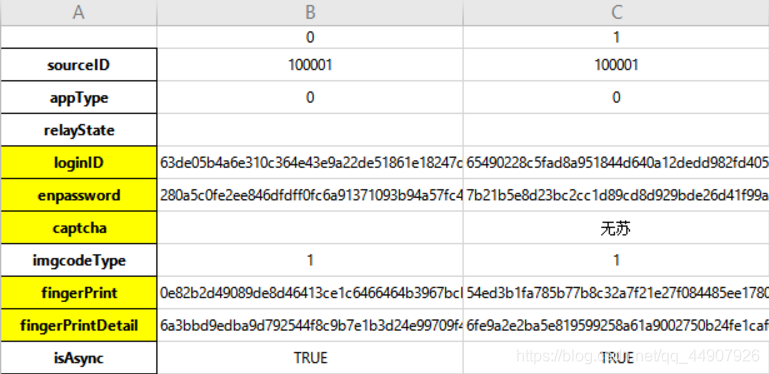
captcha参数
这个值对应的是验证码的数据,第一次登录时并没有这个验证码,提交空值给表单就可以了,验证码是账号或密码输错导致登录失败的时候会出现。这个时候会给服务器发送一条请求,返回值就是验证码经过base64编码后的数据。


enpassword参数

通过观察两次请求的参数可以看出来enpassword参数是不相同的,所以这个参数显然是动态变化生成的,再仔细观察一下发现这个值每个字符的范围都是0-9和a-f,通过我们的经验可以猜想这个参数是16进制的字符串,而且很有可能是经过加密的。
搜索enpassword参数

但是搜索发现都是HTML源码里,显然不可能包含此参数的值。经验可知此参数肯定是JS动态生成的,所以我们就看HTML源码中此参数对应的代码:(既然name值参数搜索没用,那么就来搜索一下class的值J_RsaPsd)

搜索J_RsaPsd参数

分析JS文件,会发现三个地方都有此参数,而且结构几乎一致,所以为了找到目标数据,我们将这三个都打上断点进行观察!执行观察会停在哪一个上,那我们就只分析那一个即可!

执行过程,分析可知是个RSA加密!

分析最近的一个函数,当选中var b = $(this)这句时,密码输入框标记选中,可知此句是将密码赋值给b。


进入db函数
这里看不出有什么东西,先跳过不管。

setPublic函数

这里需要传入两个参数,这两个值在上一个请求的response中可以得到,而且都是固定值。

这两个参数可以作为固定值写在代码里。

encrypt加密函数

传进去的参数b.val()在console中执行发现就是我们在密码框中输入的明文。
encrypt函数实际就是gb函数

这里是将gb函数赋值给db对象的原型对象,下面又把db对象赋值给c.RSAKey,这就是最开始定义c的语句。
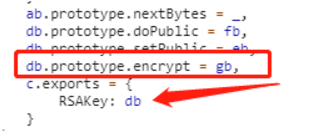
gb函数执行到c.toString(16)的时候就得到了加密结果

改写JS加密基本逻辑(下面的代码就写入改写的JS代码中)
function getEncryptedPwd(pwd, modulus, publicExponent) {
c = new RSAKey;
c.setPublic(modulus, publicExponent);
var d = c.encrypt(pwd);
return d;
}
pwd传入明文密码,modulus和publicExponent是固定值,现在只要把里面有关联的函数复制出来再进行调试就可以了。

这里是RSA加密函数定义的起止位置(注意:我们复制两个大括号内部的所有代码!)
Python调用JS加密函数(最终编写爬虫文件中使用!)
def make_encrypt_password(self, password, modulus, publicExponent):
"""生成加密后的密码
Args:
password (str): 输入框内输入的原始密码
modulus (str): rsa加密参数,两个质数的乘积,固定值,前一个请求获得
publicExponent (str): rsa加密参数,大于1的奇数,固定值,前一个请求获得
Returns:
str: 加密后的密码
"""
return self.js_object.call('getEncryptedPwd', password, modulus, publicExponent)
运行时可能会遇到的问题
-
遇到的错误1
- 报错

- 报错
- 解决方法 把alert中的中文删去

-
遇到的错误2
- 报错

- 报错
- 解决方法 定义navigator和window

-
遇到的错误3
- 报错

- 报错
- 解决方法 修改如下代码

此部分改写的最终形态JS代码:
var navigator = {},window={};
function d(a, b, c) {
null != a && ("number" == typeof a ? this.fromNumber(a, b, c) : null == b && "string" != typeof a ? this.fromString(a, 256) : this.fromString(a, b))
}
function e() {
return new d(null)
}
function f(a, b, c, d, e, f) {
for (; --f >= 0; ) {
var g = b * this[a++] + c[d] + e;
e = Math.floor(g / 67108864),
c[d++] = 67108863 & g
}
return e
}
function g(a, b, c, d, e, f) {
for (var g = 32767 & b, h = b >> 15; --f >= 0; ) {
var i = 32767 & this[a]
, j = this[a++] >> 15
, k = h * i + j * g;
i = g * i + ((32767 & k) << 15) + c[d] + (1073741823 & e),
e = (i >>> 30) + (k >>> 15) + h * j + (e >>> 30),
c[d++] = 1073741823 & i
}
return e
}
function h(a, b, c, d, e, f) {
for (var g = 16383 & b, h = b >> 14; --f >= 0; ) {
var i = 16383 & this[a]
, j = this[a++] >> 14
, k = h * i + j * g;
i = g * i + ((16383 & k) << 14) + c[d] + e,
e = (i >> 28) + (k >> 14) + h * j,
c[d++] = 268435455 & i
}
return e
}
function i(a) {
return nb.charAt(a)
}
function j(a, b) {
var c = ob[a.charCodeAt(b)];
return null == c ? -1 : c
}
function k(a) {
for (var b = this.t - 1; b >= 0; --b)
a[b] = this[b];
a.t = this.t,
a.s = this.s
}
function l(a) {
this.t = 1,
this.s = 0 > a ? -1 : 0,
a > 0 ? this[0] = a : -1 > a ? this[0] = a + this.DV : this.t = 0
}
function m(a) {
var b = e();
return b.fromInt(a),
b
}
function n(a, b) {
var c;
if (16 == b)
c = 4;
else if (8 == b)
c = 3;
else if (256 == b)
c = 8;
else if (2 == b)
c = 1;
else if (32 == b)
c = 5;
else {
if (4 != b)
return void this.fromRadix(a, b);
c = 2
}
this.t = 0,
this.s = 0;
for (var e = a.length, f = !1, g = 0; --e >= 0; ) {
var h = 8 == c ? 255 & a[e] : j(a, e);
0 > h ? "-" == a.charAt(e) && (f = !0) : (f = !1,
0 == g ? this[this.t++] = h : g + c > this.DB ? (this[this.t - 1] |= (h & (1 << this.DB - g) - 1) << g,
this[this.t++] = h >> this.DB - g) : this[this.t - 1] |= h << g,
g += c,
g >= this.DB && (g -= this.DB))
}
8 == c && 0 != (128 & a[0]) && (this.s = -1,
g > 0 && (this[this.t - 1] |= (1 << this.DB - g) - 1 << g)),
this.clamp(),
f && d.ZERO.subTo(this, this)
}
function o() {
for (var a = this.s & this.DM; this.t > 0 && this[this.t - 1] == a; )
--this.t
}
function p(a) {
if (this.s < 0)
return "-" + this.negate().toString(a);
var b;
if (16 == a)
b = 4;
else if (8 == a)
b = 3;
else if (2 == a)
b = 1;
else if (32 == a)
b = 5;
else {
if (4 != a)
return this.toRadix(a);
b = 2
}
var c, d = (1 << b) - 1, e = !1, f = "", g = this.t, h = this.DB - g * this.DB % b;
if (g-- > 0)
for (h < this.DB && (c = this[g] >> h) > 0 && (e = !0,
f = i(c)); g >= 0; )
b > h ? (c = (this[g] & (1 << h) - 1) << b - h,
c |= this[--g] >> (h += this.DB - b)) : (c = this[g] >> (h -= b) & d,
0 >= h && (h += this.DB,
--g)),
c > 0 && (e = !0),
e && (f += i(c));
return e ? f : "0"
}
function q() {
var a = e();
return d.ZERO.subTo(this, a),
a
}
function r() {
return this.s < 0 ? this.negate() : this
}
function s(a) {
var b = this.s - a.s;
if (0 != b)
return b;
var c = this.t;
if (b = c - a.t,
0 != b)
return this.s < 0 ? -b : b;
for (; --c >= 0; )
if (0 != (b = this[c] - a[c]))
return b;
return 0
}
function t(a) {
var b, c = 1;
return 0 != (b = a >>> 16) && (a = b,
c += 16),
0 != (b = a >> 8) && (a = b,
c += 8),
0 != (b = a >> 4) && (a = b,
c += 4),
0 != (b = a >> 2) && (a = b,
c += 2),
0 != (b = a >> 1) && (a = b,
c += 1),
c
}
function u() {
return this.t <= 0 ? 0 : this.DB * (this.t - 1) + t(this[this.t - 1] ^ this.s & this.DM)
}
function v(a, b) {
var c;
for (c = this.t - 1; c >= 0; --c)
b[c + a] = this[c];
for (c = a - 1; c >= 0; --c)
b[c] = 0;
b.t = this.t + a,
b.s = this.s
}
function w(a, b) {
for (var c = a; c < this.t; ++c)
b[c - a] = this[c];
b.t = Math.max(this.t - a, 0),
b.s = this.s
}
function x(a, b) {
var c, d = a % this.DB, e = this.DB - d, f = (1 << e) - 1, g = Math.floor(a / this.DB), h = this.s << d & this.DM;
for (c = this.t - 1; c >= 0; --c)
b[c + g + 1] = this[c] >> e | h,
h = (this[c] & f) << d;
for (c = g - 1; c >= 0; --c)
b[c] = 0;
b[g] = h,
b.t = this.t + g + 1,
b.s = this.s,
b.clamp()
}
function y(a, b) {
b.s = this.s;
var c = Math.floor(a / this.DB);
if (c >= this.t)
return void (b.t = 0);
var d = a % this.DB
, e = this.DB - d
, f = (1 << d) - 1;
b[0] = this[c] >> d;
for (var g = c + 1; g < this.t; ++g)
b[g - c - 1] |= (this[g] & f) << e,
b[g - c] = this[g] >> d;
d > 0 && (b[this.t - c - 1] |= (this.s & f) << e),
b.t = this.t - c,
b.clamp()
}
function z(a, b) {
for (var c = 0, d = 0, e = Math.min(a.t, this.t); e > c; )
d += this[c] - a[c],
b[c++] = d & this.DM,
d >>= this.DB;
if (a.t < this.t) {
for (d -= a.s; c < this.t; )
d += this[c],
b[c++] = d & this.DM,
d >>= this.DB;
d += this.s
} else {
for (d += this.s; c < a.t; )
d -= a[c],
b[c++] = d & this.DM,
d >>= this.DB;
d -= a.s
}
b.s = 0 > d ? -1 : 0,
-1 > d ? b[c++] = this.DV + d : d > 0 && (b[c++] = d),
b.t = c,
b.clamp()
}
function A(a, b) {
var c = this.abs()
, e = a.abs()
, f = c.t;
for (b.t = f + e.t; --f >= 0; )
b[f] = 0;
for (f = 0; f < e.t; ++f)
b[f + c.t] = c.am(0, e[f], b, f, 0, c.t);
b.s = 0,
b.clamp(),
this.s != a.s && d.ZERO.subTo(b, b)
}
function B(a) {
for (var b = this.abs(), c = a.t = 2 * b.t; --c >= 0; )
a[c] = 0;
for (c = 0; c < b.t - 1; ++c) {
var d = b.am(c, b[c], a, 2 * c, 0, 1);
(a[c + b.t] += b.am(c + 1, 2 * b[c], a, 2 * c + 1, d, b.t - c - 1)) >= b.DV && (a[c + b.t] -= b.DV,
a[c + b.t + 1] = 1)
}
a.t > 0 && (a[a.t - 1] += b.am(c, b[c], a, 2 * c, 0, 1)),
a.s = 0,
a.clamp()
}
function C(a, b, c) {
var f = a.abs();
if (!(f.t <= 0)) {
var g = this.abs();
if (g.t < f.t)
return null != b && b.fromInt(0),
void (null != c && this.copyTo(c));
null == c && (c = e());
var h = e()
, i = this.s
, j = a.s
, k = this.DB - t(f[f.t - 1]);
k > 0 ? (f.lShiftTo(k, h),
g.lShiftTo(k, c)) : (f.copyTo(h),
g.copyTo(c));
var l = h.t
, m = h[l - 1];
if (0 != m) {
var n = m * (1 << this.F1) + (l > 1 ? h[l - 2] >> this.F2 : 0)
, o = this.FV / n
, p = (1 << this.F1) / n
, q = 1 << this.F2
, r = c.t
, s = r - l
, u = null == b ? e() : b;
for (h.dlShiftTo(s, u),
c.compareTo(u) >= 0 && (c[c.t++] = 1,
c.subTo(u, c)),
d.ONE.dlShiftTo(l, u),
u.subTo(h, h); h.t < l; )
h[h.t++] = 0;
for (; --s >= 0; ) {
var v = c[--r] == m ? this.DM : Math.floor(c[r] * o + (c[r - 1] + q) * p);
if ((c[r] += h.am(0, v, c, s, 0, l)) < v)
for (h.dlShiftTo(s, u),
c.subTo(u, c); c[r] < --v; )
c.subTo(u, c)
}
null != b && (c.drShiftTo(l, b),
i != j && d.ZERO.subTo(b, b)),
c.t = l,
c.clamp(),
k > 0 && c.rShiftTo(k, c),
0 > i && d.ZERO.subTo(c, c)
}
}
}
function D(a) {
var b = e();
return this.abs().divRemTo(a, null, b),
this.s < 0 && b.compareTo(d.ZERO) > 0 && a.subTo(b, b),
b
}
function E(a) {
this.m = a
}
function F(a) {
return a.s < 0 || a.compareTo(this.m) >= 0 ? a.mod(this.m) : a
}
function G(a) {
return a
}
function H(a) {
a.divRemTo(this.m, null, a)
}
function I(a, b, c) {
a.multiplyTo(b, c),
this.reduce(c)
}
function J(a, b) {
a.squareTo(b),
this.reduce(b)
}
function K() {
if (this.t < 1)
return 0;
var a = this[0];
if (0 == (1 & a))
return 0;
var b = 3 & a;
return b = b * (2 - (15 & a) * b) & 15,
b = b * (2 - (255 & a) * b) & 255,
b = b * (2 - ((65535 & a) * b & 65535)) & 65535,
b = b * (2 - a * b % this.DV) % this.DV,
b > 0 ? this.DV - b : -b
}
function L(a) {
this.m = a,
this.mp = a.invDigit(),
this.mpl = 32767 & this.mp,
this.mph = this.mp >> 15,
this.um = (1 << a.DB - 15) - 1,
this.mt2 = 2 * a.t
}
function M(a) {
var b = e();
return a.abs().dlShiftTo(this.m.t, b),
b.divRemTo(this.m, null, b),
a.s < 0 && b.compareTo(d.ZERO) > 0 && this.m.subTo(b, b),
b
}
function N(a) {
var b = e();
return a.copyTo(b),
this.reduce(b),
b
}
function O(a) {
for (; a.t <= this.mt2; )
a[a.t++] = 0;
for (var b = 0; b < this.m.t; ++b) {
var c = 32767 & a[b]
, d = c * this.mpl + ((c * this.mph + (a[b] >> 15) * this.mpl & this.um) << 15) & a.DM;
for (c = b + this.m.t,
a[c] += this.m.am(0, d, a, b, 0, this.m.t); a[c] >= a.DV; )
a[c] -= a.DV,
a[++c]++
}
a.clamp(),
a.drShiftTo(this.m.t, a),
a.compareTo(this.m) >= 0 && a.subTo(this.m, a)
}
function P(a, b) {
a.squareTo(b),
this.reduce(b)
}
function Q(a, b, c) {
a.multiplyTo(b, c),
this.reduce(c)
}
function R() {
return 0 == (this.t > 0 ? 1 & this[0] : this.s)
}
function S(a, b) {
if (a > 4294967295 || 1 > a)
return d.ONE;
var c = e()
, f = e()
, g = b.convert(this)
, h = t(a) - 1;
for (g.copyTo(c); --h >= 0; )
if (b.sqrTo(c, f),
(a & 1 << h) > 0)
b.mulTo(f, g, c);
else {
var i = c;
c = f,
f = i
}
return b.revert(c)
}
function T(a, b) {
var c;
return c = 256 > a || b.isEven() ? new E(b) : new L(b),
this.exp(a, c)
}
function U() {
this.i = 0,
this.j = 0,
this.S = new Array
}
function V(a) {
var b, c, d;
for (b = 0; 256 > b; ++b)
this.S[b] = b;
for (c = 0,
b = 0; 256 > b; ++b)
c = c + this.S[b] + a[b % a.length] & 255,
d = this.S[b],
this.S[b] = this.S[c],
this.S[c] = d;
this.i = 0,
this.j = 0
}
function W() {
var a;
return this.i = this.i + 1 & 255,
this.j = this.j + this.S[this.i] & 255,
a = this.S[this.i],
this.S[this.i] = this.S[this.j],
this.S[this.j] = a,
this.S[a + this.S[this.i] & 255]
}
function X() {
return new U
}
function Y(a) {
qb[rb++] ^= 255 & a,
qb[rb++] ^= a >> 8 & 255,
qb[rb++] ^= a >> 16 & 255,
qb[rb++] ^= a >> 24 & 255,
rb >= sb && (rb -= sb)
}
function Z() {
Y((new Date).getTime())
}
function $() {
if (null == pb) {
for (Z(),
pb = X(),
pb.init(qb),
rb = 0; rb < qb.length; ++rb)
qb[rb] = 0;
rb = 0
}
return pb.next()
}
function _(a) {
var b;
for (b = 0; b < a.length; ++b)
a[b] = $()
}
function ab() {}
function bb(a, b) {
return new d(a,b)
}
function cb(a, b) {
if (b < a.length + 11)
return alert("Message too long for RSA"),
null;
for (var c = new Array, e = a.length - 1; e >= 0 && b > 0; ) {
var f = a.charCodeAt(e--);
128 > f ? c[--b] = f : f > 127 && 2048 > f ? (c[--b] = 63 & f | 128,
c[--b] = f >> 6 | 192) : (c[--b] = 63 & f | 128,
c[--b] = f >> 6 & 63 | 128,
c[--b] = f >> 12 | 224)
}
c[--b] = 0;
for (var g = new ab, h = new Array; b > 2; ) {
for (h[0] = 0; 0 == h[0]; )
g.nextBytes(h);
c[--b] = h[0]
}
return c[--b] = 2,
c[--b] = 0,
new d(c)
}
function db() {
this.n = null,
this.e = 0,
this.d = null,
this.p = null,
this.q = null,
this.dmp1 = null,
this.dmq1 = null,
this.coeff = null
}
function eb(a, b) {
null != a && null != b && a.length > 0 && b.length > 0 ? (this.n = bb(a, 16),
this.e = parseInt(b, 16)) : alert("")
}
function fb(a) {
return a.modPowInt(this.e, this.n)
}
function gb(a) {
var b = cb(a, this.n.bitLength() + 7 >> 3);
if (null == b)
return null;
var c = this.doPublic(b);
if (null == c)
return null;
var d = c.toString(16);
return 0 == (1 & d.length) ? d : "0" + d
}
var hb, ib = 0xdeadbeefcafe, jb = 15715070 == (16777215 & ib);
jb && "Microsoft Internet Explorer" == navigator.appName ? (d.prototype.am = g,
hb = 30) : jb && "Netscape" != navigator.appName ? (d.prototype.am = f,
hb = 26) : (d.prototype.am = h,
hb = 28),
d.prototype.DB = hb,
d.prototype.DM = (1 << hb) - 1,
d.prototype.DV = 1 << hb;
var kb = 52;
d.prototype.FV = Math.pow(2, kb),
d.prototype.F1 = kb - hb,
d.prototype.F2 = 2 * hb - kb;
var lb, mb, nb = "0123456789abcdefghijklmnopqrstuvwxyz", ob = new Array;
for (lb = "0".charCodeAt(0),
mb = 0; 9 >= mb; ++mb)
ob[lb++] = mb;
for (lb = "a".charCodeAt(0),
mb = 10; 36 > mb; ++mb)
ob[lb++] = mb;
for (lb = "A".charCodeAt(0),
mb = 10; 36 > mb; ++mb)
ob[lb++] = mb;
E.prototype.convert = F,
E.prototype.revert = G,
E.prototype.reduce = H,
E.prototype.mulTo = I,
E.prototype.sqrTo = J,
L.prototype.convert = M,
L.prototype.revert = N,
L.prototype.reduce = O,
L.prototype.mulTo = Q,
L.prototype.sqrTo = P,
d.prototype.copyTo = k,
d.prototype.fromInt = l,
d.prototype.fromString = n,
d.prototype.clamp = o,
d.prototype.dlShiftTo = v,
d.prototype.drShiftTo = w,
d.prototype.lShiftTo = x,
d.prototype.rShiftTo = y,
d.prototype.subTo = z,
d.prototype.multiplyTo = A,
d.prototype.squareTo = B,
d.prototype.divRemTo = C,
d.prototype.invDigit = K,
d.prototype.isEven = R,
d.prototype.exp = S,
d.prototype.toString = p,
d.prototype.negate = q,
d.prototype.abs = r,
d.prototype.compareTo = s,
d.prototype.bitLength = u,
d.prototype.mod = D,
d.prototype.modPowInt = T,
d.ZERO = m(0),
d.ONE = m(1),
U.prototype.init = V,
U.prototype.next = W;
var pb, qb, rb, sb = 256;
if (null == qb) {
qb = new Array,
rb = 0;
var tb;
if (window.crypto && window.crypto.getRandomValues) {
var ub = new Uint8Array(32);
for (window.crypto.getRandomValues(ub),
tb = 0; 32 > tb; ++tb)
qb[rb++] = ub[tb]
}
if ("Netscape" == navigator.appName && navigator.appVersion < "5" && window.crypto) {
var vb = window.crypto.random(32);
for (tb = 0; tb < vb.length; ++tb)
qb[rb++] = 255 & vb.charCodeAt(tb)
}
for (; sb > rb; )
tb = Math.floor(65536 * Math.random()),
qb[rb++] = tb >>> 8,
qb[rb++] = 255 & tb;
rb = 0,
Z()
}
ab.prototype.nextBytes = _,
db.prototype.doPublic = fb,
db.prototype.setPublic = eb,
db.prototype.encrypt = gb,
RSAKey = db
function getEncryptedPwd(pwd, modulus, publicExponent) {
c = new RSAKey;
c.setPublic(modulus, publicExponent);
var d = c.encrypt(pwd);
return d;
}
运行结果
python编写脚本运行此JS代码:
import execjs
password = '123' # 模拟的密码(随便写的!)
modulus = '00833c4af965ff7a8409f8b5d5a83d87f2f19d7c1eb40dc59a98d2346cbb145046b2c6facc25b5cc363443f0f7ebd9524b7c1e1917bf7d849212339f6c1d3711b115ecb20f0c89fc2182a985ea28cbb4adf6a321ff7e715ba9b8d7261d1c140485df3b705247a70c28c9068caabbedbf9510dada6d13d99e57642b853a73406817'
publicExponent = '010001'
def make_execjs_object():
with open('en_pwd.js', 'r') as f:
js = f.read()
return execjs.compile(js)
js_object = make_execjs_object()
a = js_object.call('getEncryptedPwd', password, modulus, publicExponent)
print(a)
运行结果:

loginID 参数
步骤同上面的enpassword,一步步搜索会发现找到了图中的J_RsaAccout,这个就是loginID参数的加密:(我们继续一步步分析,会发现此参数的加密方式和刚刚的enpassword的加密方式一模一样,那处理方法不就简单了!)

JS加密账号函数(直接将下面的JS函数加入刚刚自己改写的JS代码文件中即可!)
function getEncryptedAccount(account, modulus, publicExponent) {
c = new RSAKey;
c.setPublic(modulus, publicExponent);
var d = c.encrypt(account);
return d;
}
Python调用JS加密函数(编写爬虫脚本文件时用以下函数调用JS文件生成所需参数!形同enpassword的写法)
def make_encrypt_account(self, account, modulus, publicExponent):
"""生成加密后的账号
Args:
account (str): 输入框内输入的账号
modulus (str): 同上
publicExponent (str): 同上
Returns:
str: 加密后的账号
"""
return self.js_object.call('getEncryptedAccount', account, modulus, publicExponent)
运行结果

FingerPrint和FingerPrintDetail参数
找到指纹加密的主函数(会发现就在刚刚的函数下面)

分析函数功能
这里比较不好理解的是$.fingerprint.details和$.fingerprint.result,这两个变量的定义位置是下面图片这里

这两个值也都是固定值,据观察,其中c的值就是使用者计算机的一些属性,只要计算机不换,这些值就是固定的,所以我们直接传固定值即可(它也不知道你电脑信息是啥样的呀);而且d的值是根据c的值得出的,所以也可以写死!后面编写爬虫代码时直接复制此处的值即可!

修改FingerPrint的JS函数
function rsaFingerprint(a, b, details, result) { //details和result是固定值,直接作为参数传进来赋值; 此处的a和b的值通过观察可知就是a.result.modulus和a.result.publicExponent这俩值,前面获取过!
var c = details
, d = result
, e = c.length
, f = ""
, g = new RSAKey;
g.setPublic(a, b);
for (var h = g.encrypt(d), i = 0; e > i; i += 117)
f += g.encrypt(c.substr(i, 117));
// return {
// details: f,
// result: h
// }
return {
fingerPrintDetail: f, //这里代码会返回字典类型的数据,直接可以合并到表单里,所以直接修改为表单里可以用的key值。当然不改也可!
fingerPrint: h
}
}
Python调用JS加密函数
def make_rsa_fingerprint(self, modulus, publicExponent, details, result):
"""生成rsa指纹参数
Args:
details (str): 请求headers信息
result (str): headers的加密信息,如果headers不改变这个值也是固定的
Returns (dict):
details: 加密后的fingerprint_details信息,fingerPrintDetail表单参数
result: 加密后的fingerprint_result信息,fingerPrint表单参数
"""
return self.js_object.call('rsaFingerprint', modulus, publicExponent, details, result)
运行结果

编写爬虫脚本:
(1)首先,编写脚本构造出post表单!
import requests
import json
import execjs
class Migu_login(object):
def __init__(self, account, password):
modules = '00833c4af965ff7a8409f8b5d5a83d87f2f19d7c1eb40dc59a98d2346cbb145046b2c6facc25b5cc363443f0f7ebd9524b7c1e1917bf7d849212339f6c1d3711b115ecb20f0c89fc2182a985ea28cbb4adf6a321ff7e715ba9b8d7261d1c140485df3b705247a70c28c9068caabbedbf9510dada6d13d99e57642b853a73406817'
publicExponent = '010001'
# 获取FingerPrint和FingerPrintDetail参数中JS函数所需的参数c和d
details_params = '"{"user_agent":"Mozilla/5.0 (Windows NT 10.0; Win64; x64) AppleWebKit/537.36 (KHTML, like Gecko) Chrome/84.0.4147.89","language":"zh-CN","color_depth":"24","pixel_ratio":"1.25","hardware_concurrency":"8","resolution":"1536,864","available_resolution":"1536,834","timezone_offset":"-480","session_storage":"1","local_storage":"1","indexed_db":"1","open_database":"1","cpu_class":"unknown","navigator_platform":"Win32","do_not_track":"unknown","regular_plugins":"Chrome PDF Plugin::Portable Document Format::application/x-google-chrome-pdf~pdf,Chrome PDF Viewer::","webgl_vendor":"Google Inc.~ANGLE (Intel(R) UHD Graphics 620 Direct3D11 vs_5_0 ps_5_0)","adblock":"false","has_lied_languages":"false","has_lied_resolution":"false","has_lied_os":"false","has_lied_browser":"false","touch_support":"0,false,false","js_fonts":"Arial,Arial Black,Arial Narrow,Arial Unicode MS,Book Antiqua,Bookman Old Style,Calibri,Cambria,Cambr"}"'
result_params = '984eb0bda24963a23008f493d58a84e0'
headers = {
"Accept": "application/json, text/javascript, */*; q=0.01",
"Accept-Encoding": "gzip, deflate, br",
"Accept-Language": "zh-CN,zh;q=0.9,en;q=0.8",
"Cache-Control": "no-cache",
"Connection": "keep-alive",
"Host": "passport.migu.cn",
"Origin": "https://passport.migu.cn",
"Referer": "https://passport.migu.cn/login?sourceid=208003&apptype=0&forceAuthn=false&isPassive=false&authType=MiguPassport&passwordControl=0&display=web&referer=https://www.migu.cn/&logintype=1&qq=null&weibo=null&alipay=null&weixin=null&andPass=null&phoneNumber=&callbackURL=https%3A%2F%2Fwww.migu.cn%2F&relayState=",
"Sec-Fetch-Dest": "empty",
"Sec-Fetch-Mode": "cors",
"Sec-Fetch-Site": "same-origin",
"User-Agent": "Mozilla/5.0 (Windows NT 10.0; Win64; x64) AppleWebKit/537.36 (KHTML, like Gecko) Chrome/84.0.4147.89 Safari/537.36",
"X-Requested-With": "XMLHttpRequest",
}
self.form = {
# 需要传递的构造出来的参数先写空,后面再使用update即可!
"sourceID": "208003",
"appType": "0",
"relayState": "",
"loginID":"", # 加密后的账号
"enpassword": "", # 加密后的密码
"captcha": "",
"rememberMeBox": "1",
"fingerPrint": "", # 指纹
"fingerPrintDetail":"", # 指纹detail
"isAsync": True,
}
# 开启会话,保持连接!
self.session = requests.Session()
self.session.headers = headers
self.get_cookie()
# Python执行JS代码,生成所需参数并更新进表单
self.js_object = self.compile_js()
update_form = self.make_rsa_fingerprint(modules, publicExponent, details_params, result_params)
update_form['loginID'] = self.make_encrypt_account(account, modules, publicExponent)
update_form['enpassword'] = self.make_encrypt_password(password, modules, publicExponent)
self.form.update(update_form)
def compile_js(self):
"""
python直接执行本地编写的JS代码
:return:
"""
with open('en_pwd.js', 'r') as f:
js = f.read()
return execjs.compile(js)
def get_cookie(self):
"""
为了让会话携带cookie,所以进行如下操作。因为使用的session会话技术,所以即使不return也携带了cookie等一系列参数。
:return:
"""
url = 'https://passport.migu.cn/'
self.session.get(url)
return self.session.cookies
def make_encrypt_password(self, password, modulus, publicExponent):
"""生成加密后的密码
Args:
password (str): 输入框内输入的原始密码
modulus (str): rsa加密参数,两个质数的乘积,固定值,前一个请求获得
publicExponent (str): rsa加密参数,大于1的奇数,固定值,前一个请求获得
Returns:
str: 加密后的密码
"""
return self.js_object.call('getEncryptedPwd', password, modulus, publicExponent)
def make_encrypt_account(self, account, modulus, publicExponent):
"""生成加密后的账号
Args:
account (str): 输入框内输入的账号
modulus (str): 同上
publicExponent (str): 同上
Returns:
str: 加密后的账号
"""
return self.js_object.call('getEncryptedAccount', account, modulus, publicExponent)
def make_rsa_fingerprint(self, modulus, publicExponent, details, result):
"""生成rsa指纹参数
Args:
details (str): 请求headers信息
result (str): headers的加密信息,如果headers不改变这个值也是固定的
Returns (dict):
details: 加密后的fingerprint_details信息,fingerPrintDetail表单参数
result: 加密后的fingerprint_result信息,fingerPrint表单参数
"""
return self.js_object.call('rsaFingerprint', modulus, publicExponent, details, result)
(2)然后,编写脚本发送请求并通过获取响应判断是否登录成功!

分析可知,我们应该向如上图中的url携带表单发送post请求!
第一步:直接向其发送请求,观察响应,是否为登录成功的界面!
def login(self):
"""
登录函数
:return:
"""
url = 'https://passport.migu.cn/authn'
response = self.session.post(url, data=self.form)
print(response.text)
if __name__ == '__main__':
# 注意:账号密码放在了info.txt中
with open('info.txt', 'r') as f:
info = json.loads(f.read())
act = info['account']
pwd = info['password']
mg = Migu_login(act,pwd)
mresponse = mg.login()
观察响应分析可知,当我们登录成功之后,页面进行了重定向,而不是直接返回给我们登录成功的界面:

第二步:所以下面我们要做的就是,通过分析浏览器登录,找到一系列的重定向的URL,并找到最终返回登录成功界面的URL:
第一个登录成功之后出现的URL,很容易知道这就是登录后的重定向,其URL的构造只需要拼接token参数即可(token参数在刚刚的响应中又存在,直接提取即可!)

第二个登录成功之后出现的URL,多次测试可知其URL是固定值!

第三个登录成功之后出现的URL,图一中多次测试也可知其URL是固定值;图二中可知此URL刚好是由上一个URL跳转来的;图三可知此URL的响应刚好是登录成功的界面!

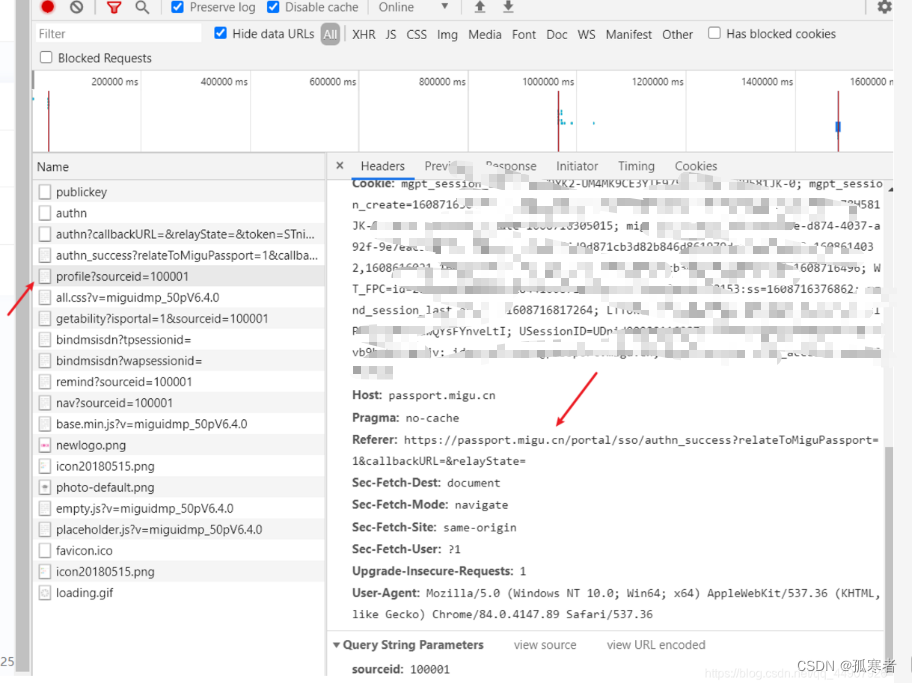

第三步:构造登录成功之后的重定向URL,并通过依此请求模拟网站登录时候的一次次重定向跳转,最终达到获取咪咕登录成功的界面!
def login(self):
"""
登录函数
:return:
"""
url = 'https://passport.migu.cn/authn'
response = self.session.post(url, data=self.form)
response_dict = json.loads(response.text)
token = response_dict.get('result',{}).get('token', '')
if not token:
return
rest_url = [
'https://passport.migu.cn/portal/sso/authn?callbackURL=&relayState=&token={}'.format(token),
'https://passport.migu.cn/portal/sso/authn_success?relateToMiguPassport=1&callbackURL=&relayState=',
'https://passport.migu.cn/portal/home/profile?sourceid=100001',
'https://passport.migu.cn/portal/home/profile?sourceid=100001',
]
for ru in rest_url:
response = self.session.get(ru)
return response
if __name__ == '__main__':
with open('info.txt', 'r') as f:
info = json.loads(f.read())
act = info['account']
pwd = info['password']
mg = Migu_login(act,pwd)
mresponse = mg.login()
print(mresponse.text)
(3)观察可知登录成功!

项目源码链接:
代码:
链接:https://pan.baidu.com/s/1zM19dGyvEpX4BuXsr_8s7Q
提取码:xkxh
复制这段内容后打开百度网盘手机App,操作更方便哦

![BUUCTF-Real-ThinkPHP]5.0.23-Rce](https://img-blog.csdnimg.cn/direct/b9e802ae77ed4893b4b9746c72e589b3.png)
